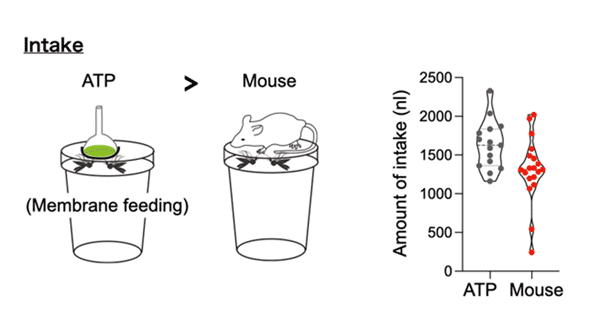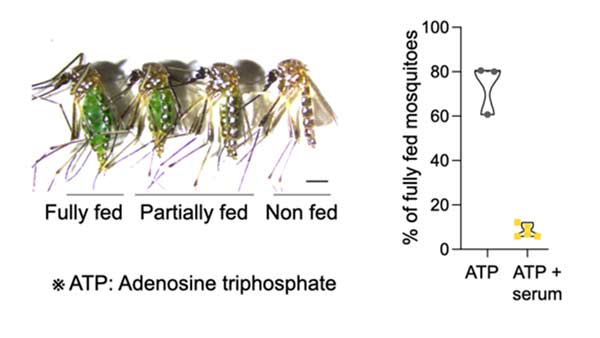Research Results
Elucidating the Mechanism of Mosquito Blood Feeding
Identification of Signals Associated with the Termination of Mosquito Blood FeedingFY2025

- SAKUMA Chisako (Senior Scientist, Laboratory for Nutritional Biology, RIKEN Center for Biosystems Dynamics Research)
- Fusion Oriented Research for Disruptive Science and Technology (FOREST)
- Comprehensive Understanding of the Gustatory Regulation of Blood Feeding in the Yellow Fever Mosquitoes, Aedes aegypti (2021- up to 10 years)
Identification of Signals That Cause Mosquitoes to terminate Blood feeding at "Moderate Fullness"
A research group including Chisako Sakuma, Senior Scientist at the Laboratory for Nutritional Biology, RIKEN Center for Biosystems Dynamics Research, and colleagues identified that fibrinopeptide A (FPA)*1 in mammal blood has the effect of causing Aedes aegypti*2 to cease blood feeding (Fig.1).
Mosquitoes are attracted to humans by carbon dioxide, smell, body temperature, etc., and after landing on the skin, they pierce it with their stylets and taste the blood in the blood vessels to determine whether or not to feed. The decisive factor is adenosine triphosphate (ATP) in the blood. When ATP is detected by mosquitoes, it serves as a signal for the mosquitoes to start feeding on blood.
However, mosquitoes that begin to feed on blood stop doing so at a moderate level of fullness before reaching satiety. According to one theory, satiety is considered to slow down movement and thus pose danger for mosquitoes. Yet, the mechanism by which mosquitoes can cease blood feeding at a moderate level of fullness despite the ATP-induced drive to feed remained a mystery.
Dr. Sakuma et al. hypothesized that mosquitoes have signals that stop feeding once they reach a certain level of fullness, similar to how humans and animals secrete various hormones during and after eating to regulate food intake. The researchers advanced studies and identified that FPA, known to be a substance involved in blood coagulation, serves as a signal to stop blood feeding.
Elucidating the mechanism that suppress mosquito blood-feeding may lead to the artificial control of blood feeding and prevention of perilous mosquito-borne diseases.
*1 Fibrinopeptide A (FPA), fibrin, and fibrinogen
Substances that are involved in blood coagulation. When fibrinopeptide A (FPA) is cleaved from the precursor protein fibrinogen, unstable fibrin is produced. Further, cleavage of fibrinopeptide B and the polymerization of the fibrin form insoluble blood clots. FPA is a short amino acid polymer (peptide) comprising 16 amino acids in total length.
*2 Aedes aegypti
A species of blood-feeding Aedes genus. The mosquito is widely found in tropical and subtropical regions and mediates viruses that cause dengue fever and Zika fever.

Fig.1 Mechanism of Termination of Mosquito Blood Feeding When a mosquito feeds on blood, the signal that stops blood feeding, FPA, accumulates in the mosquito's body, causing it to terminate feeding.
Transmission of Disease Pathogens through Mosquitoes' Blood-Feeding Behavior
When bitten by mosquitoes, itchiness develops in the skin and lasts for a while. Everyone has likely encountered such an annoying experience. However, this is not the only harm caused by mosquitoes' blood feeding behavior. A single mosquito can feed on multiple humans, thereby posing the risk of transmitting pathogens of infectious diseases, such as Japanese encephalitis, malaria, and dengue fever, from infected individuals to healthy ones. These infections are primarily prevalent in tropical and subtropical regions, but they can be brought to Japan through the travel of people and goods between countries. Additionally, due to rising temperatures from global warming, the habitat of Aedes albopictus is gradually expanding to northern regions of Japan. To prevent the transmission of infectious disease pathogens by these mosquitoes, research is conducted to understand the mechanisms of mosquito blood-feeding behavior and to explore methods for artificial blood-feeding control.
Search for Substances Involved in the Termination of Aedes aegypti Blood Feeding
The research group of Dr. Sakuma and colleagues searched for substances involved in the termination of blood feeding using female A. aegypti, a member of the Aedes genus.
First, to determine whether blood contains substances that stop blood feeding, mouse blood and ATP solution, which promotes mosquito blood feeding, were used to compare blood-feeding behavior by mosquitoes. As a result, mosquitoes that fed on the ATP solution were found to ingest more than those that fed blood directly from the mice. It was therefore anticipated that some component in the blood functions as an inhibitor of mosquito blood feeding. Furthermore, since blood feeding terminates before satiety, this substance was considered to rapidly increase or activate in the latter half of the feeding period (Fig.2).
Subsequently, to identify the substance that inhibits blood feeding, Dr. Sakuma et al. separated blood into serum and erythrocytes and examined blood-feeding behavior. Because serum contains ATP at very low levels, mosquitoes do not ingest serum if it is given alone. Interestingly, when serum was added to the ATP solution and given to mosquitoes, the rate of mosquitoes that fed until satiety significantly decreased compared to when the ATP solution was given alone. This revealed that serum has the effect of stopping blood feeding midway (Fig.3). Serum was thus fractionated using high-performance liquid chromatography and analyzed by mass spectrometry, leading to the identification of fibrinopeptide A as the component that ceases blood feeding. Fibrinopeptide A is a substance produced during blood coagulation. Examination of the mosquito's body during and after blood feeding revealed that the level of fibrinopeptide A was high when mosquitoes terminate blood feeding and increased during feeding period.
Moreover, when mosquitoes were given ATP solution added with artificially synthesized fibrinopeptide A and mouse blood treated with a blood coagulation inhibitor (heparin), mosquitoes stopped feeding blood before satiety in the presence of fibrinopeptide A, whereas blood feeding was promoted until satiety with blood that did not contain fibrinopeptide A.
Additionally, upon observing the mosquito's body at multiple time points after blood feeding, it was found that the blood inside the body gradually darkened and eventually formed a solid mass of blood.
These results revealed that fibrinopeptide A is the signal that stops mosquitoes from feeding on blood. When mosquitoes start feeding, the blood ingested from the host's blood vessels into the mosquito's body begins to coagulate, and fibrinopeptide A begins to be produced. The level of fibrinopeptide A increases as blood feeding progresses, and when it reaches a certain level, mosquitoes likely sense this and terminate blood feeding before reaching satiety.

Fig.2 Comparison of the Amount of ATP Solution and Mouse Blood Ingested into the Body A. aegypti ingested a larger volume when given ATP solution (green solution) via membrane feeding compared to when it directly fed from the mouse. The dots in the graph represent individual mosquitoes subject to the experiment. The ingestion volume unit, nL (nanoliter), is one billionth of a liter.

Fig.3
Rate of Fully Fed Mosquitoes When Serum is Added to ATP Solution
(Left) Analysis of ATP solution intake in A. aegypti blood-feeding behavior. By feeding mosquitoes with green-colored ATP solution, the state of ingestion was classified into three levels: fully fed (abdomen distended by colored ATP solution), partially fed (abdomen colored and partially distended), and non-fed (no abdomen coloring or distension).
(Right) Effect of serum on ATP solution ingestion. While the majority of A. aegypti are fully fed when ingesting ATP solution alone, the rate of fully fed mosquitoes decreases when serum is added.
Anticipation for Application to the Control of Mosquito-Borne Diseases
This study elucidated the presence of a signal in the blood that stops mosquito blood feeding. These results shed light on parts of the mechanism by which mosquitoes stop feeding blood after moderate fullness despite the presence of a blood-feeding signal in the blood.
If further research clarifies the mechanism by which fibrinopeptide A, identified in the present study, works in the mosquito body to stop blood feeding, it is expected to be applied to the development of methods for artificially inducing blood feeding termination and controlling mosquito-borne diseases. Humans have historically devised various methods to prevent mosquito bites, including mosquito nets and insecticides. A new strategy is about to be added to the fight.
- Life Science
- Research Results
- Japanese
